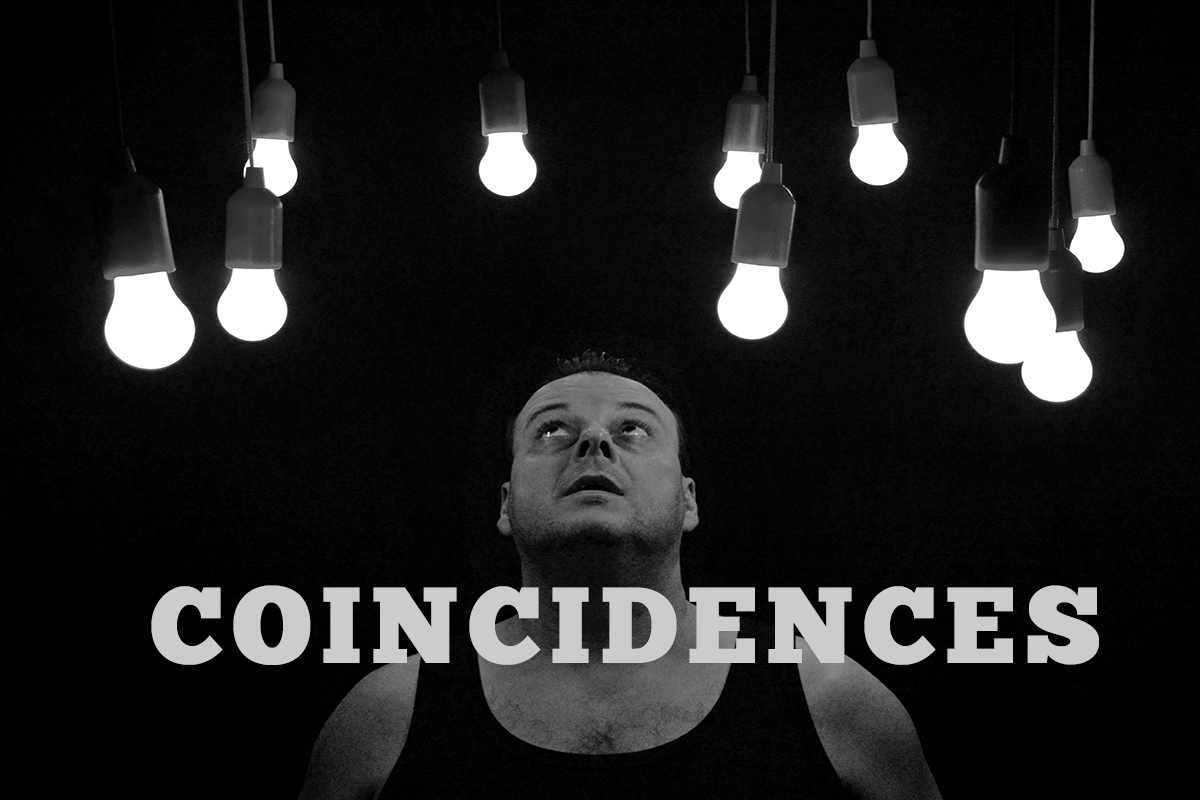CRAZY COINCIDENCES

What do they signify?
The entire phenomenon of coincidences has an aura of mystery about it. Though science prefers to explain them as mere random events, open-minded researchers are reluctant to dismiss them outright as such. They believe that these occurrences have a meaning and a cosmic purpose to fulfil that has to be deciphered. Yet, all these explanations may touch but a fringe of this problem.
A story was told in 2001 in which a 10-year-old girl named Laura Buxton, celebrating her grandparents’ 50th wedding anniversary, released from the front yard of her home on a small farm in Staffordshire, England, a red-coloured helium balloon. Urged by her grandfather, she attached to the balloon a note- “Please return to Laura Buxton”, together with her address. The wind was strong and the balloon floated across the cloudless sky. It travelled about 140 miles south and descended, finally landing on the yard of another 10-year-old girl in Wiltshire, who too was named Laura Buxton. After contacting each other and talking about the curious coincidence, the two girls decided to meet whereupon they discovered a whole range of weird similarities. They looked and dressed alike: they were of the same height and had brown hair and wore it in the same style, their eye colour was blue, they wore a pink sweater and jeans; they had three-year-old black Labrador Retrievers and grey pet rabbits at home; unintentionally both brought their guinea pigs, which were the same colour, even having the same orange markings on their hindquarters. It appeared as if these two Laura Buxtons were the same person.


The mathematician Joseph Mazur, born in the U. S. in 1942, in his book Fluke, recounts an experience of the world-famous French romantic poet Émile Deschamps (1791-1871). As a teenager the poet met in Orleans in France a Frenchman named Mr. de Fortgibu who had recently returned from England and who introduced him to a delectable English treat called “plum pudding” for the first time. About a decade later, on Christmas eve, Deschamps saw this culinary delight on a restaurant menu. His mouth watered and he rushed into the restaurant. When he ordered the pudding, the waiter said that the last one had been sold already to a man in the back of the restaurant, who, surprisingly, turned out to be Mr. de Fortgibu. After another decade Deschamps went to a dinner party where the plum pudding was served. He joked that the party must be for Mr. de Fortgibu who then inexplicably appeared at the door at that very moment. Mr. de Fortgibu had accidentally come to a wrong restaurant on his way to another dinner party.
In the 1838 fiction of the American writer and poet Edgar Allan Poe (1809-1849) four famishing crew members of a shipwreck finally take the macabre decision to kill and eat a 12-year-old boy named Richard Parker for survival. In 1884 this fiction was transformed to reality when a vessel, due to a violent storm, suffered shipwreck and only four people survived. The cabin boy, also named Richard Parker, fell ill after drinking sea water and the rest of the crew, out of desperation, decided to kill and eat the boy. On reaching the shore, the surviving crew members were charged with murder.
In 1929, the American novelist Anne Parrish (1888-1957), was ambling along the Seine, river in northern France, and stopped at a book stall to browse titles. Jack Frost and Other Stories, one of her favourite titles, caught her attention. She bought the copy for one franc. When she showed the copy to her husband, who was sitting at a nearby café, he was flabbergasted on seeing what was written inside: her name and address. The copy had been hers, when she was a child.
The first and the last British soldiers killed in the First World War are buried in the Saint Symphorien Military Cemetery in Belgium. Their graves are located just six meters apart and their headstones face each other, but the burial was not a prearrangement.
The stories of this genre-improbable concurrence of seemingly related events or circumstances that have no causal relation-are found the world over from all epochs and would fill a book running for pages. Almost everyone, including the present writer, has experienced this phenomenon, which has left them stunned. It has puzzled scientists, philosophers and mathematicians who are trying to unravel the mystery that surrounds these uncanny happenings and to fathom the hidden reasons and forces lying behind them.
Hippocrates (460-370 BC), the Greek physician, suggested that coincidences were nothing but sympathetic elements seeking each other because the world was one big land mass not separated by water. Arthur Schopenhauer (1788-1860), the German philosopher, claimed that coincidences were nothing but “simultaneous happenings of unconnected events”.
According to Prof. Katie Mack, an American theoretical cosmologist, our entire universe could be described as a coincidence, as we exist in an implausibly unlikely false vacuum that could collapse at any time if it came into contact with a true vacuum.
David J. Hand, a professor of mathematics from London, and author of The Improbability Principle, that investigates the statistical probabilities of extremely unlikely circumstances, thinks that there is a deeper implication at work regarding such incidents. He believes that highly improbable events are commonplace and are merely a consequence of the mathematics of chance coupled with the human’s psychology.
Many people think that coincidences are God’s way of remaining anonymous. Yet, statistically oriented people believe that they are mostly random events. In their opinion, coincidences can be explained by the Law of Truly Large Numbers, which states that in large populations any weird event is likely to happen. “Coincidences are nothing but strange yet expectable events that we remember because they are surprising to us. They are no coincidences, just random events”, they argue. But no general consensus has been reached as yet as to what they really are. Those who are against the ‘random’ theory, insist that all coincidences have meaning and nothing happens by chance. According to them cause and effect are an illusion.
Paul Kammerer (1880-1926) was an Austrian biologist who studied and advocated Lamarckism [named after the French zoologist Jean-Baptiste Lamarck (1744-1829)], the theory that organisms may pass to their offspring physical characteristics acquired in their lifetime. His other passion was collecting coincidences. His book Das Gesetz der Serie (The Law of the Series), written in German, narrated some 100 anecdotes of coincidences that prompted him to formulate his theory of seriality. He postulated that all events are connected by waves of seriality and unknown forces would cause what is perceived as groupings and coincidences. This theory was extended by Wolfgang Pauli (1900-1958), another Austrian and a Nobel prize-winning physicist and a pioneer in quantum physics, together with the eminent German psychologist Carl Gustav Jung (1875-1961) by introducing the concept of synchronicity. They asserted that the acausal principle of synchronicity led to the occurrence of coincidences. Jung, who believed in psychic phenomena, coined the word synchronicity from the Greek words syn—with, together—and chronos—time. (Synchronicity, thus, means moving-together-in-time.) He defined the term as the coming together of inner and outer events in a way that cannot be explained by cause and effect albeit meaningful to the observer. Jung claimed that the fundamental characteristic of synchronicity is the surprise that occurs when a thought in the mind is mirrored by an external event to which it has no apparent causal connection.

Paul Kammerer (1880-1926)
Arthur Koestler (1905-1983), a Hungarian British author and science journalist, carried out extensive research into the phenomenon of coincidences to search out a scientific basis for this occurrence and explained it as “puns of destiny”.
His famous book The Roots of Coincidence (1972) points out links between modern physics and their interaction with time and paranormal phenomena. Koestler was influenced by Jung’s concept of synchronicity and Kammerer’s theory of seriality. In this book he argued that science should give serious thought to the phenomena that lie outside our common view of the world and study them. He concluded that paranormal events are rare, unpredictable and capricious and need a paradoxical combination of proper scientific experiment with a childlike excitement to be seen and recorded. Yet, David Francis Marks, an English psychologist (born in 1945), criticised Koestler’s book for endorsing pseudoscience. John Beloff (1920-2006), another English psychologist, gave the book a mixed review, noting that some of Koestler’s claims about psychical research were inaccurate.
Nevertheless, coincidental or synchronistic events seem to defy all logic and are devoid of a rational explanation by the natural laws of cause and effect. Since they have significance to the observer – and are often profoundly life-changing – these events have long fascinated humankind.
Paulo Coelho de Souza (born in 1947) is a Brazilian lyricist and novelist who is best known for his allegorical best-selling novel O Alquimista, written in Portuguese and published in 1988. It was translated into English in 1993 as The Alchemist. The idea of coincidences as signs and guidance is a major theme of Coelho’s work, including the said novel that has sold over 65 million copies worldwide in over 160 countries, being translated into 71 languages. Clearly, despite the views of the sceptics, there is universal appeal for the phenomenon of coincidences and the like. In Coelho’s view, coincidence is the language of the stars, the universe. “According to the ancient alchemists and to the physicists of today, everything is just one thing only”, he says.
It is now believed that our mind, like the universe we live in, is holographic. Each part of it knows the whole. Just as each cell of our body has information about our entire body, our mind has information about the whole universe.
Meanwhile, some researchers have theorised that people having intuitive powers are more prone to experience coincidences.
Surprisingly, coincidences occur in the most trivial things in our lives. But, not always! Just think of the prospect of becoming a millionaire overnight if the randomly chosen winning numbers happened to match those in the lottery ticket you bought the previous day! A coincidence of great import to you, would have changed the entire course of your life.
Kammerer and Koestler shared a passion for coincidences. Kammerer, following an accusation of fraud in a biological experiment he conducted, committed suicide in a forest in Austria. Koestler, who was diagnosed with terminal leukaemia, committed suicide together with his wife at their London home.
Two persons with a common interest died in an identical manner. Another case of coincidence! We do not know. ***







